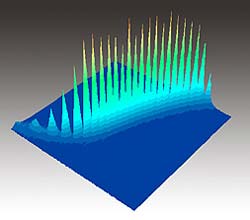Cell Phone Still Too Big? Micro-Oscillators May Help

A three-dimensional plot shows how the microwave frequency (x axis) generated by a new NIST oscillator varies with changes in the current (y axis). The height of each peak represents the power of the signal produced at specific frequencies.
A tiny, novel device for generating tunable microwave signals has been developed by researchers at the National Institute of Standards and Technology (NIST). Described in the Jan. 16 issue of Physical Review Letters, the device measures just a few micro-meters square and is hundreds of times smaller than typical microwave signal generators in use today in cell phones, wireless Internet devices, radar systems and other applications.
The device works by exploiting the fact that individual electrons in an electric current behave like minuscule magnets, each one with a “spin” that is either up or down, just as an ordinary magnet has a north and a south pole.
The NIST device consists of two magnetic films separated by a non-magnetic layer of copper. As an electric current passes through the first magnetic film, the electrons in the current align their spins to match the magnetic orientation in the film. But when the now aligned electrons flow through the second magnetic film, the process is reversed. This time the alignment of the electrons is transferred to the film. The result is that the magnetization of the film rapidly switches direction, or oscillates, generating a microwave signal. The microwave signal can be tuned from less than 5 gigahertz (5 billion oscillations a second) to greater than 40 GHz.
The NIST experiments confirm predictions made by theorists at IBM Corp. and Carnegie Mellon University in 1996.
NIST physicist William Rippard says the new oscillators can be built into integrated circuits with the same technologies now used to make computer chips and that they may eventually replace bulkier technologies at a greatly reduced cost.
Media Contact
More Information:
http://www.nist.gov/public_affairs/techbeat/tb2004_0116.htm#oscillatorAll latest news from the category: Physics and Astronomy
This area deals with the fundamental laws and building blocks of nature and how they interact, the properties and the behavior of matter, and research into space and time and their structures.
innovations-report provides in-depth reports and articles on subjects such as astrophysics, laser technologies, nuclear, quantum, particle and solid-state physics, nanotechnologies, planetary research and findings (Mars, Venus) and developments related to the Hubble Telescope.
Newest articles

Bringing bio-inspired robots to life
Nebraska researcher Eric Markvicka gets NSF CAREER Award to pursue manufacture of novel materials for soft robotics and stretchable electronics. Engineers are increasingly eager to develop robots that mimic the…

Bella moths use poison to attract mates
Scientists are closer to finding out how. Pyrrolizidine alkaloids are as bitter and toxic as they are hard to pronounce. They’re produced by several different types of plants and are…

AI tool creates ‘synthetic’ images of cells
…for enhanced microscopy analysis. Observing individual cells through microscopes can reveal a range of important cell biological phenomena that frequently play a role in human diseases, but the process of…





















